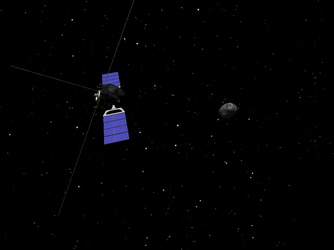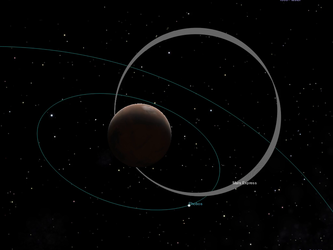Accept all cookies Accept only essential cookies See our Cookie Notice

About ESA
The European Space Agency (ESA) is Europe’s gateway to space. Its mission is to shape the development of Europe’s space capability and ensure that investment in space continues to deliver benefits to the citizens of Europe and the world.
Highlights
ESA - United space in Europe
This is ESA ESA facts Member States & Cooperating States Funding Director General Top management For Member State Delegations European vision European Space Policy ESA & EU Space Councils Responsibility & Sustainability Annual Report Calendar of meetings Corporate newsEstablishments & sites
ESA Headquarters ESA ESTEC ESA ESOC ESA ESRIN ESA EAC ESA ESAC Europe's Spaceport ESA ESEC ESA ECSAT Brussels Office Washington OfficeWorking with ESA
Business with ESA ESA Commercialisation Gateway Law at ESA Careers Cyber resilience at ESA IT at ESA Newsroom Partnerships Merchandising Licence Education Open Space Innovation Platform Integrity and Reporting Administrative Tribunal Health and SafetyMore about ESA
History ESA Historical Archives Exhibitions Publications Art & Culture ESA Merchandise Kids Diversity ESA Brand CentreLatest
Space in Member States
Find out more about space activities in our 23 Member States, and understand how ESA works together with their national agencies, institutions and organisations.
Science & Exploration
Exploring our Solar System and unlocking the secrets of the Universe
Go to topicAstronauts
Missions
Juice Euclid Webb Solar Orbiter BepiColombo Gaia ExoMars Cheops Exoplanet missions More missionsActivities
International Space Station Orion service module Gateway Concordia Caves & Pangaea BenefitsLatest
Space Safety
Protecting life and infrastructure on Earth and in orbit
Go to topicAsteroids
Asteroids and Planetary Defence Asteroid danger explained Flyeye telescope: asteroid detection Hera mission: asteroid deflection Near-Earth Object Coordination CentreSpace junk
About space debris Space debris by the numbers Space Environment Report In space refuelling, refurbishing and removingSafety from space
Clean Space ecodesign Zero Debris Technologies Space for Earth Supporting Sustainable DevelopmentLatest
Applications
Using space to benefit citizens and meet future challenges on Earth
Go to topicObserving the Earth
Observing the Earth Future EO Copernicus Meteorology Space for our climate Satellite missionsCommercialisation
ESA Commercialisation Gateway Open Space Innovation Platform Business Incubation ESA Space SolutionsLatest
Enabling & Support
Making space accessible and developing the technologies for the future
Go to topicBuilding missions
Space Engineering and Technology Test centre Laboratories Concurrent Design Facility Preparing for the future Shaping the Future Discovery and Preparation Advanced Concepts TeamSpace transportation
Space Transportation Ariane Vega Space Rider Future space transportation Boost! Europe's Spaceport Launches from Europe's Spaceport from 2012Latest

Mars Express peers beneath the surface of Phobos
Thank you for liking
You have already liked this page, you can only like it once!
The MARSIS instrument on ESA's Mars Express spacecraft was originally designed to study the internal structure of Mars. As a result, it was designed for use at the typical distance between the spacecraft and the planet’s surface – more than 250 km.
But it recently received a major software upgrade that allows it to be used at much closer distances and which could help to shed light on the mysterious origin of the moon Phobos.
“During this flyby, we used MARSIS to study Phobos from as close as 83 km,” says Andrea Cicchetti from the MARSIS team at INAF. “Getting closer allows us to study its structure in more detail and identify important features we would never have been able to see from further away."
The top-right image shows the ‘radargram’ acquired by MARSIS during the flyby of Phobos on 23 September 2022. A radargram reveals the ‘echoes’ created when the radio signal emitted by MARSIS bounces off something and returns to the instrument. The brighter the signal, the more powerful the echo.
The continuous bright line shows the echo from the moon’s surface. The lower reflections are either ‘clutter’ caused by features on the moon’s surface, or, more interestingly, signs of possible structural features below the surface (e).
Section A—C was recorded using an older configuration of the MARSIS software. The new configuration was prepared during the ‘technical gap’ and successfully used for the very first time from D—F.
The left and bottom-right images show the path of the observation across the surface of Phobos.
MARSIS is operated by the Istituto Nazionale di Astrofisica (INAF), Italy, and funded by the Italian Space Agency (ASI).
-
CREDIT
INAF - Istituto Nazionale di Astrofisica -
LICENCE
ESA Standard Licence

Mars Express makes closest-ever Phobos fly by

Artist's impression of Mars Express and Phobos

Mars Express makes closest-ever Phobos fly by as see…

Mars Express makes closest-ever Phobos fly - view fr…















 Germany
Germany
 Austria
Austria
 Belgium
Belgium
 Denmark
Denmark
 Spain
Spain
 Estonia
Estonia
 Finland
Finland
 France
France
 Greece
Greece
 Hungary
Hungary
 Ireland
Ireland
 Italy
Italy
 Luxembourg
Luxembourg
 Norway
Norway
 The Netherlands
The Netherlands
 Poland
Poland
 Portugal
Portugal
 Czechia
Czechia
 Romania
Romania
 United Kingdom
United Kingdom
 Slovenia
Slovenia
 Sweden
Sweden
 Switzerland
Switzerland























